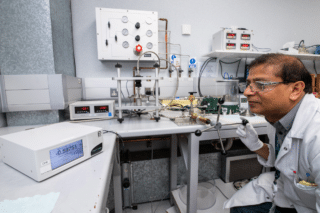Nuclear fusion has the potential to unleash virtually unlimited supplies of clean energy to power the world and replace carbon energy. Many projects are under development, particularly in Europe. But the recent and major breakthrough comes from the United States where a laboratory has managed to produce 1.5 times more energy than it needed to do so. This world premiere was announced yesterday and brings hope for the future of a clean, decarbonized energy system.
Adam Turner contributed to this report.
American scientists from the Lawrence Livermore National Laboratory’s National Ignition Facility in California (LLNL) successfully produced a nuclear fusion reaction with positive net energy. It was announced yesterday by the U.S. Department of Energy (DOE) and DOE’s National Nuclear Security Administration.
Until now, nuclear fusion experiments consumed more energy than they produced. But the American physicists were able to generate 3.15 megajoules of energy while the 192 lasers that were used to trigger the physical reaction projected only 2.05 megajoules. This net energy gain is a world premiere that brings many hopes for the future of a safe and sustainable energy system.
The Biden White House welcomed this achievement. The administration has indeed made nuclear fusion a priority in its climate plan and is investing US$723 million in fusion energy sciences. Joe Biden believes commercial fusion “has the potential to revolutionize the energy industry“.

What is Nuclear Fusion?
Nuclear energy is a source of electricity. Today, nuclear power plants rely on the process of nuclear “fission” to produce that electricity. The idea is to split heavy atoms like uranium and plutonium. This reaction releases vast amounts of energy.
The major issue with fission is that the reactors produce long-lived radioactive waste which remains dangerous for thousands, or even millions of years. And this waste we still don”t know what to do with it.
But there is another, safer alternative, the process of nuclear “fusion”. Instead of splitting atoms, the idea is to propel two atoms at a very high speed, hoping that they will fuse together, and release energy. It is the same reaction that occurs at the heart of stars. On Earth, fusion is achieved using hydrogen isotopes like deuterium and tritium.
While fusion also unleashes vast amounts of energy, the process is more stable than fission and produces much smaller amounts of short-lived radioactive waste. In theory, the heat produced by fusion reactors can be used to generate electricity, similar to today’s fission reactors. Unfortunately, mankind has found it is much harder to fuse atoms than to split them. Until yesterday.
RELATED ARTICLE
What Process Did the LLNL Use?
At the heart of the Sun, vast gravitational pressures allow fusion to occur at temperatures of 10 million Celsius. On Earth, fusion requires temperatures above 100 million Celsius. As no materials exist which can withstand direct contact with such heat, scientists must use other methods to contain super-heated plasma.
Different nuclear technologies are being tested to generate a nuclear fusion reaction.
The Joint European Torus (JET) experiment, at the UK Atomic Energy Authority’s facility in Oxford and the International Thermonuclear Experimental Reactor (ITER) project in France, rely on tokamak’s magnetic confinement to contain superheated plasma in the shape of a doughnut, or torus. In March, the JET experiments produced 59 megajoules of energy over five seconds, the equivalent of 11 megawatts of power.
Other fusion projects rely on inertial confinement, using lasers to squeeze and heat the plasma. This is what the LLNL scientists have experimented with success, as they explained on their website:
“To create fusion ignition, the National Ignition Facility’s laser energy is converted into X-rays inside the hohlraum, which then compress a fuel capsule until it implodes, creating a high temperature, high-pressure plasma.”
In this process, the idea is to project lasers on a 1 mm fuel capsule. The lasers heat the capsule and condensate it so that it explodes and releases energy.

When Will the Commercialization of Fusion Be Ready?
However, according to experts, the commercialization of nuclear fusion might take a decade. Despite these encouraging results, there are many challenges to building a future no longer reliant on fossil fuels but on new clean fusion energy. We still don’t know how to maintain fusion for more than several seconds, how to generate vast amounts of energy, or how to transport it to consumption sites. For example, the electricity generated by the JET project was only enough to boil 60 kettles.
As a result, fusion is unlikely to be a major contributor toward the global goal of reaching net-zero CO2 emissions by 2050. But it could come to fruition in the second half of the century.
In an interview with DirectIndustry last March, ITER Director General, Dr. Bernard Bigot said:
“For the ITER Project, the JET results are a strong confidence builder that we are on the right track as we move forward toward demonstrating full fusion power. A sustained pulse of deuterium-tritium fusion at this power level – nearly industrial scale – delivers a resounding confirmation to all of those involved in the global fusion quest.”











